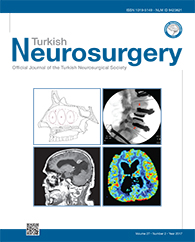2Belgrade University, School of Medicine, Clinical Center of Serbia, Clinic of Neurosurgery, Belgrade, Serbia DOI : 10.5137/1019-5149.JTN.15106-15.0 AIM: The surgical management of injured digital nerves is a common part of hand trauma surgery. Despite improvements in the surgical techniques and suture material, the final outcomes of peripheral nerve repair can still be disappointing. This study investigates the outcomes following the surgical treatment of traumatic digital nerve lesions of the hand.
MATERIAL and METHODS: 150 consecutive patients with acutely digital nerve injuries were treated through by primary repair in our Unit between January 2005 and December 2009. 126 were male, 24 female (male/female ratio of 5.25:1), with an age range of 16-70 years, and a mean follow-up of 30 months. All 150 patients underwent primary epineural suture within 48 hours of their injury. Sensory recovery was assessed using the Medical Research Council scale (MRC). Sensibility testing was performed after a minimum of 12 months. Disabilities of the Arm, Shoulder and Hand scores (DASH) were used to evaluate the functional outcomes.
RESULTS: Eighteen patients (9.33%) had excellent sensibility with two-point discrimination test (S2PD) of ≤ 7 mm (S4). Forty-one patients (21.24%) achieved good sensibility (S2PD ≤ 15 mm, S3+), 76 (39.38%) achieved S3, 55 (28.50%) had poor sensibility (S2 and S1), and two patients had no sensibility (S0). The mean functional DASH score was 9.0 in our group of patients.
CONCLUSION: There was a significant correlation between patient age, mechanism of injury and nerve recovery, with younger patients and patients with narrow zone of injury achieving better sensory recoveries.
Keywords : Digital nerve, Nerve repair, Hand injury




